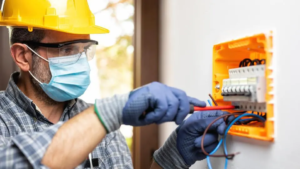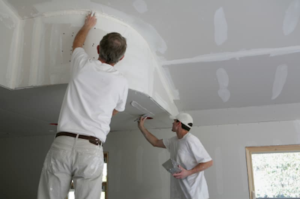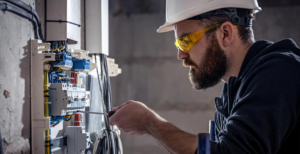Roofing maintenance includes roof inspection and repair, gutter cleaning and removal of debris. It also includes a thorough look at roof flashing (the sealant around chimneys, vents, skylights and other rooftop penetrations) to identify and address problems before they lead to leaks and water damage.

In addition, it ensures that attic insulation and ventilation are working properly which helps reduce energy costs. It also protects the investment in your home or business. Reach out to North Port FL Roofing for expert assistance.
One of the most important things you can do for your roof is to inspect it regularly. There are many things you should look for, including missing shingles that need to be replaced. Damaged shingles are more susceptible to leaks and can lead to water damage in your home.
It is also a good idea to check the gutters for any signs of debris that need to be removed. Gutters are responsible for removing rainwater and directing it away from the foundation of your house, so clogged gutters can cause major problems.
If you notice that your shingles are starting to curl or have become discolored, it is a sign that they need to be replaced. This may be due to harsh weather, animals chewing on the roof or just normal wear and tear. Missing shingles can leave your home exposed to water leaks, which will lead to rotting wood and mold in the attic or walls of your house.
Another thing to keep an eye out for is shingle granules in the gutters. Asphalt shingles contain small gravel-like particles that naturally loosen and fall off of the shingle, and when they find their way into your gutters, it is a sign that the shingle is wearing out. If you see a lot of these granules, it is a good idea to contact Industry Elite Services for a roofing inspection.
While most shingle damage can be seen from the ground, there are some issues that may only be spotted with a professional roof inspection. If you notice any of the following signs, call a professional for an immediate repair:
Leaking and Water Damage
Look around your home for shingles that are lifting, curled or missing. These need to be repaired immediately to avoid water leaks. You should also check for any dents in your roof’s structure or attic and look for wet insulation and mold.
A common issue with shingle roofs is moss and algae growth. These organisms are more likely to grow in shady or damp areas, and they can trap moisture that can speed up shingle deterioration. Spraying your roof with a 50/50 mix of bleach and water can help kill the organisms and allow it to dry quickly. Alternatively, you can use zinc or copper strips to inhibit their growth.
Inspect Your Gutters
Gutters play a critical role in the health of your roof and should be inspected regularly for leaks, clogs, and other damage. In addition to protecting your home from water damage, gutters are also important for directing water runoff away from the foundation of your house, helping prevent moisture problems such as wood rot and mold.
A reliable gutter system should properly divert water runoff 4 to 6 feet away from the home’s foundation. If it doesn’t, the excess moisture will saturate the soil around the foundation and then wick into the building, leading to problems such as cracking foundation walls and damp basements. A professional home inspector will look at the condition of your gutters and downspouts as part of the roof portion of a thorough home inspection.
Inspectors will start by looking at the condition of the gutters from the ground, examining their overall appearance and checking for signs of leaks or damage. They will also check that the gutters are attached securely to the fascia boards and soffits. If the gutters are pulling away from the house, it’s a sign that they need to be re-secured or replaced. Inspectors will also check for signs of rust or corrosion on gutter components such as downspouts, elbows, end caps and seams. Inspectors will also test the gutters by pouring water into them to see if they’re leaking or if any water is pooling.
If the inspector notices that your gutters are frequently clogged despite regular cleaning, they may recommend installing gutter guards to prevent future blockages. They will also use the opportunity to examine other areas of the home’s exterior such as the soffits, chimneys and flashing to ensure they are in good condition. In some cases, the inspector might need to climb inside the attic of your home to inspect the interior structure of the roof and ensure that the supports are secure. They will also inspect the attic for signs of moisture leaking into the home. This is a common problem that can be prevented by having proper attic insulation installed when the roof is originally constructed.
Inspect Your Chimney
The chimney and fireplace system in a home is an important part of the overall structure. However, it is susceptible to a lot of wear and tear and can suffer from many different issues. Whether these are external signs like cracks or leaning, internal problems such as a crumbling flue liner or a broken damper, or structural damage from water leaks, it is important to have any chimney and fireplace system issues addressed promptly to prevent small problems from getting worse.
The structure of a chimney deteriorates over time due to normal wear and tear, age and weathering. In addition, a chimney can experience serious problems from chimney fires that result in significant and costly repairs. To ensure a safe chimney, it is recommended that all homeowners perform some basic inspections on a regular basis. These inspections should include a visual examination of the exterior and interior of the chimney, as well as a check for any problems such as water leaks or deterioration.
A homeowner can perform some of these checks by simply walking around the outside of their chimney or if they are comfortable on a ladder climbing to the top of the roof. They should look for bricks and mortar that need to be reset or repointed, as well as to make sure that there is no creosote buildup inside the flue. They should also check for the presence of a chimney cap and that it is securely attached.
Another easy inspection to do is to examine the flashing. The flashing is the metal that seals the joint between the chimney and the roof, preventing water from entering into the chimney. If the flashing is rusty or loose, it needs to be replaced. Water stains on the ceiling or walls around the chimney are a sign that there is a leak.
A professional chimney sweep can perform a more thorough inspection of the chimney and fireplace system, including checking inside the chimney with a camera. They can also test the integrity of a chimney by using a smoke bomb and a heat detection tool to determine if it is in good working condition. They can even provide a detailed report of their findings. They can advise a homeowner of any necessary maintenance and recommend the best options for repair.
Inspect Your Attic
Performing routine attic inspections can help homeowners identify and address issues such as air leakage, moisture intrusion and pest infestations. It also helps ensure that the insulation and ventilation systems are functioning properly. This can reduce energy costs, improve indoor comfort and help maintain a healthy living environment.
An attic inspection should include examining the structural components of the attic “floor,” including the attic joists and beams, as well as checking for signs of damage to the roof cover and shingles. In addition, it’s a good idea to check the attic for signs of mold or water stains, which could indicate that there are roof leaks. Inspectors should also look for rust or cracking on the rafters and trusses. If these structural members are damaged, they may begin to sag or break, which can compromise the stability of the roof and cause serious damage to the home’s interior.
In addition, homeowners should inspect the attic for ducts and pipes that are vented through the attic. According to Cooper, the majority of attic leaks occur around these vents. Inspectors should ensure that all vents and ducts are extending through the roof to the outside and are not leaning against the attic. If they’re not, this can cause problems with condensation, leading to mold and rot.
Other items that should be checked during an attic inspection include a vapor barrier, drip edges, the condition of flashing and the integrity of ridge vents and soffit vents. Inspectors should also look for any areas where daylight can be seen, which is a sign of a leak or a hole in the attic or roof. Inspectors should also pay attention to the condition of the attic hatch and remove any obstructions that prevent easy access.
It’s important for homeowners to wear proper attire during an attic inspection, including a hard hat or cap and safety glasses. They should also be prepared with a ladder, a harness and a tool kit. Inspectors should avoid walking on the ceiling or climbing over joists, which could lead to falling debris and injury. They should also be careful not to step on any plumbing or fire sprinkler lines, which can cause significant damage and potentially result in a major health hazard.








